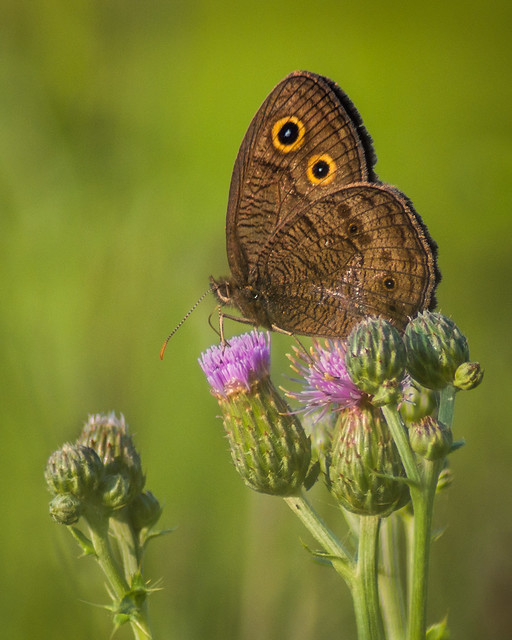Brown
Phoebe Feast
 This little bird was planning on a big lunch. This is an Eastern Phoebe that had captured a large flying bug and seemed intent on showing it off before taking it home to the family.
This little bird was planning on a big lunch. This is an Eastern Phoebe that had captured a large flying bug and seemed intent on showing it off before taking it home to the family.
I’d been watching this little bird fly around the yard. It would often land on the chain-linked fence post not far from me. I decided to position myself as close as thought I could be without scaring the bird from landing again. Then I simply stood and waited with my camera focused on the top of that post. It took a little while, but it finally landed and, to my delight, had a huge bug in its beak. (In the near future, I’ll share a profile photo of this bird; where you can see the bug a bit better.)
On the website All About Songbirds, they share about the Eastern Phoebe – “The Eastern Phoebe is a plump songbird with a medium-length tail. It appears large-headed for a bird of its size. The head often appears flat on top, but phoebes sometimes raise the feathers up into a peak. Like most small flycatchers, they have short, thin bills used for catching insects. The Eastern Phoebe generally perches low in trees or on fencelines. Phoebes are very active, making short flights to capture insects and very often returning to the same perch. They make sharp “peep” calls in addition to their familiar “phoebe” vocalizations. When perched, Eastern Phoebes wag their tails down and up frequently.”
I snapped this in a shaded area and I was still far enough away it required quite a bit of cropping to get this view.
This is one image you’ll really want to view full-screen. To do so, simply click on the photo.
All of the photos I post are available for purchase. If you’d like to buy one, click on the blue “Buy this Online” bar below for a variety of print and frame options or contact me (pops@popsdigital.com) for digital purchase and licensing options.
Strange Life Form

Butterflies are such beautiful creatures with the colors and patterns of their wings. However, up close, they have the face only an alien mother could love. This photo is a stark reminder – though whimsical in flight and beautiful from a distance, they are still flying insects.
I believe this is a Blue Morpho butterfly. If you could see it with its wings open, you would see a spectacular, iridescent blue color. The Blue Morpho is among the largest butterflies in the world with wing spans from five to eight inches. Blue morphos live in the tropical forests of Latin America from Mexico to Colombia.
On this photographic trip to the Butterfly Palace in Branson, Missouri I tried, unsuccessfully, to capture one of them with their wings open. You can view their beautiful blue in a photo I captured on a previous trip here: Common Blue Morpho
This is one you may want to view in larger size to see more of the detail. (Or not…if bugs aren’t your thing.) To do so, simply click on the photo.
All of the photos I post are available for purchase. If you’d like to buy one, click on the blue “Buy this Online” bar below for a variety of print and frame options or contact me for digital purchase and licensing options.
Pauper’s Throne

This unlikely king takes a rather stately stance on an even more unlikely throne. This brown butterfly was photographed at the edge of our backyard in rural N.E. Wisconsin.
I spent a good deal of time looking for a similar butterfly on Google. I’m sure I looked through thousands of images, but was never able to find another that looked just like it. Consequently, I have no idea what kind of butterfly it was.
You can get a closer look by viewing the full-screen version by simply clicking on the image.
All of the photos I post are available for purchase. If you’d like to buy one, click on the blue “Buy this Online” bar below for a variety of print and frame options or contact me for digital purchase and licensing options.
Dead Leaf Butterfly

Look closely or you’ll miss it. At first glance, this appears to be a leaf but, wait…it has legs and antennae! This is the cleverly disguised Dead Leaf Butterfly (Kallima inachus), sometimes called Orange Oakleaf.
When its wings are closed, it looks like a dried leaf. This incredibly effective, natural camouflage helps it avoid predators. When open, its wings are predominately a bluish-black with striking orange markings. In my next post, I’ll give you a view of this same butterfly with it’s wings open.
This cool creature is a nymphalid butterfly found in tropical Asia from India to Japan.
You can get a better view of the detail in this wing by looking at the larger version; available by clicking on the photo.
All of the photos I post are available for purchase. If you’d like to buy one, click on the blue “Buy this Online” bar below for a variety of print and frame options or contact me for digital purchase and licensing options.


















































